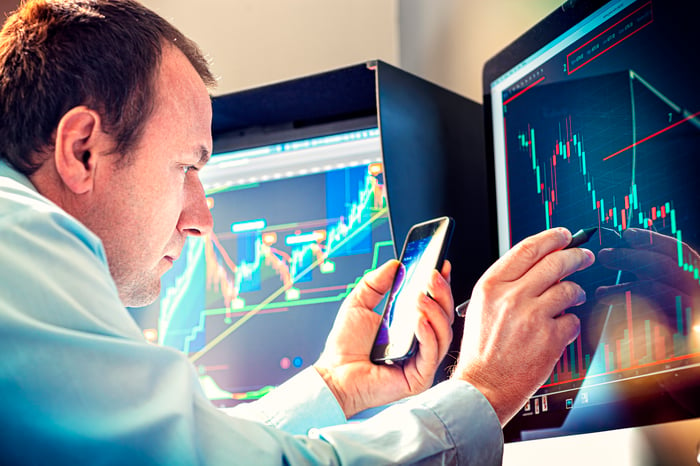Over long periods, Wall Street is a money machine for patient investors. But this doesn't mean there aren't valuation dislocations along the way.
Following the COVID-19 crash in February to March 2020, the combination of fiscal stimulus and historically low lending rates created a period of euphoria for the stock market that lasted well into 2021. Dozens of growth stocks that were viewed as game changers ascended to the heavens, only to come crashing back down to Earth in the two years that followed.

Image source: Getty Images.
While some investors are rightly leery of putting their money to work in stocks that have plunged by roughly 90% from their all-time highs, select billionaire investors are unfazed. Based on the latest round of Form 13F filings with the Securities and Exchange Commission, billionaires can't stop buying three former high-flying stocks that are down anywhere from 89% to 93% from their intraday peaks.
Plug Power: Down 89% from its all-time high
The first beaten-down highflier that at least one billionaire money manager can't stop buying is hydrogen fuel-cell solutions provider Plug Power (PLUG 1.26%). Since peaking at $75.49 per share on Jan. 26, 2021, shares of the company have tumbled 89%.
The billionaire in question that's been an avid buyer of Plug Power shares is Philippe Laffont of Coatue Management. Laffont's fund added approximately 4.46 million shares during the June-ended quarter, which brought Coatue's existing position to almost 4.94 million shares.
The excitement investors shared during the initial stages of the pandemic had to do with a combination of Plug Power landing two meaningful joint ventures, as well as demand for crude oil (at least temporarily) falling off a cliff. Investor expectations were high that green-energy solutions, such as hydrogen fuel cells, would play a major role in future transportation needs. When coupled with the company's international joint ventures, it appeared Plug had a clear path to sustainable double-digit growth.
However, the company's sales ascent only tells part of the story. While Plug Power has ambitions of hitting $20 billion in annual sales by 2030, which will be (pun intended) fueled by hydrogen fuel-cell-powered vehicles and refueling/storage infrastructure, the company isn't anywhere close to recurring profitability.
Plug's desire to build out infrastructure for its green hydrogen ecosystem is costing a pretty penny, and the company has relied on dilutive share issuances as a means to raise capital. Forecasts of the company turning the corner to recurring profitability in 2023 just a few years ago have now been pushed back to 2026 by Wall Street analysts.
While there's no doubt fuel-cell solutions could play a role in the future of mass transportation, Plug hasn't demonstrated to investors that it has the ability to reach recurring profitability. Until investors see clear steps taken in that direction, Plug Power remains a high-risk investment.
Fiverr International: Down 92% from its all-time high
A second former high-flying growth stock that's been attracting the attention of billionaire money managers is online-services marketplace Fiverr International (FVRR 3.74%). Since peaking at an intraday high of $336, shares of the company have tumbled 92%.
Two billionaire investors have been buyers of Fiverr stock, including Israel Englander of Millennium Management and Jeff Yass of Susquehanna International. Englander's fund nearly doubled its existing position by purchasing 711,218 shares of Fiverr in the second quarter, while Yass's Susquehanna did more than double its stake with a 75,052-share purchase.
Fiverr's stock soared on the hope that remote work would be a sustainable new norm in the wake of the COVID-19 pandemic. However, the arrival of COVID-19 vaccines, the lessening of COVID-19 mitigation measures, and concerns about how artificial intelligence (AI) may affect freelancer jobs in the years to come have all weighed on the company over the past two years. Nevertheless, there are reasons to be optimistic.
For instance, even though some workers have returned to the office, more have chosen to remain remote than prior to the pandemic. This permanent shift in the labor force plays right into Fiverr's hands.
Secondly, Fiverr's platform offers a key differentiation that buyers really seem to appreciate. Whereas most of the company's competitors allow freelancers to price their services on an hourly basis, Fiverr freelancers are presenting their jobs as inclusive packages. The price transparency buyers are receiving with Fiverr is unmatched, which is probably why spend per buyer has continued to climb.
But the key differentiator that makes Fiverr an intriguing long-term buy is its take-rate -- i.e., the percentage of each negotiated deal, inclusive of fees, it gets to keep. While most of its peers have take-rates in the mid-teens, Fiverr's has expanded all the way to 30.7% without chasing away its freelancers or buyers.

Image source: Getty Images.
Teladoc Health: Down 93% from its all-time high
The third former high-flying growth stock that billionaires can't stop buying is telemedicine leader Teladoc Health (TDOC -2.40%). Since hitting an intraday peak of $308 per share, Teladoc has tanked 93%.
Like Fiverr, Teladoc has had sustained buying interest from two billionaire fund managers. Jim Simons of Renaissance Technologies added close to 1.04 million shares of Teladoc stock during the second quarter, while Jeff Yass of Susquehanna International picked up nearly 190,000 additional shares.
The investor optimism that initially sent Teladoc to north of $300 was fueled by the belief that virtual visits would become the new norm during, and well after, the pandemic. While Teladoc did see a significant uptick in virtual visit revenue, the company's losses ballooned. It also didn't help that Teladoc, in hindsight, grossly overpaid for applied health signals company Livongo Health in 2020.
While things haven't gone as planned for Teladoc Health optimists, there are still reasons to be excited about the future.
For example, Teladoc's virtual visit platform is changing the personalized-care landscape in America. In instances where a virtual visit makes sense, it's allowing physicians to keep closer tabs on their patients who require extra monitoring, and giving patients an easier way to get in contact with their doctor. This all translates into improved patient outcomes and lower out-of-pocket costs for health insurers. It's a win for everyone involved.
Teladoc is also seeing steady growth in its subscription-driven businesses, BetterHelp and Livongo. As of the June-ended quarter, BetterHelp and Livongo's chronic care program enrollment totaled 476,000 and 1.073 million, respectively, which is up 17% and 7% from the prior-year period. Both of these subscription programs are just scratching the surface of a very large pool of potential patients.
Lastly, Teladoc Health has moved past its $13.4 billion in goodwill impairment charges tied to its Livongo buyout. Having cleaner year-over-year comparisons that allow investors to focus on the company's steady growth rate has the potential to lead to a higher valuation over time.





